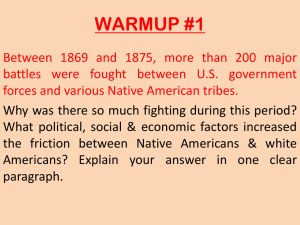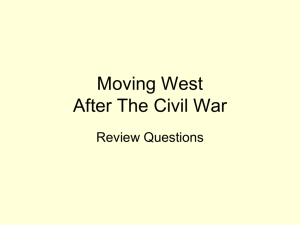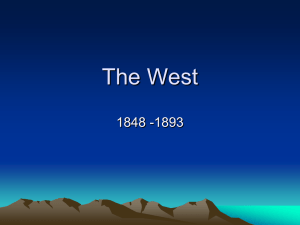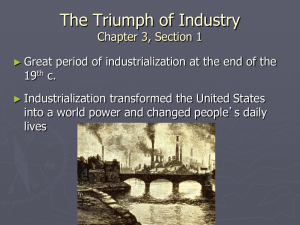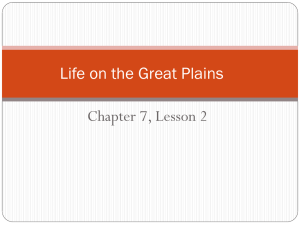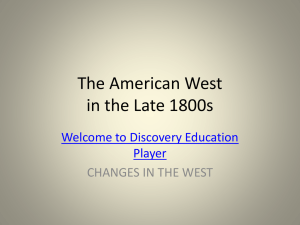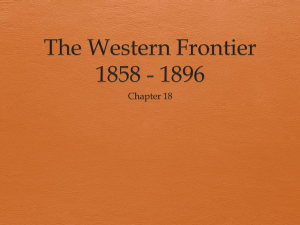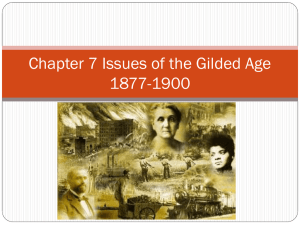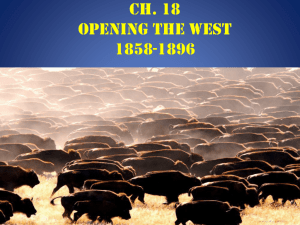09 TAJMT Chapter 04
advertisement
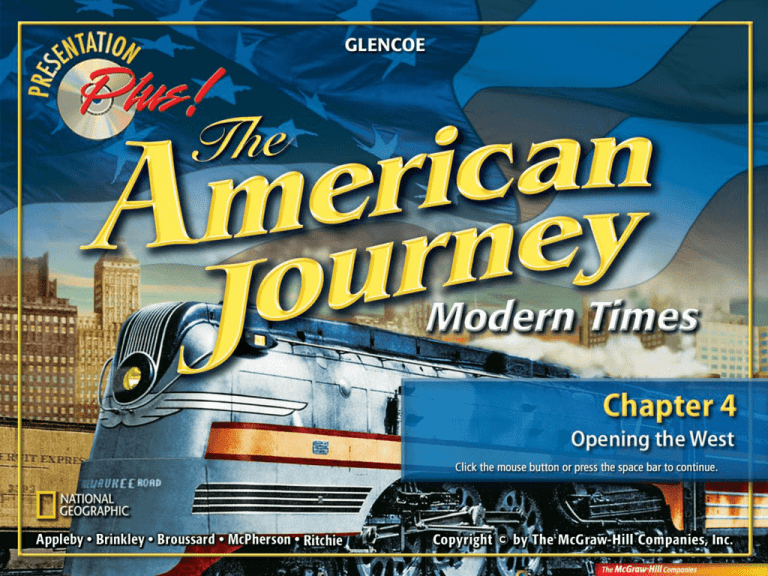
Chapter Introduction Section 1: The Mining Booms Section 2: Ranchers and Farmers Section 3: Native American Struggles Section 4: Farmers in Protest Visual Summary The Mining Booms Essential Question What were the causes and effects of mining booms in the West? Ranchers and Farmers Essential Question How did cattle ranchers and farmers adapt to life in the West? Native American Struggles Essential Question How did westward expansion affect Native Americans? Farmers in Protest Essential Question Why did economic reform movements develop in the late 1800s? What were the causes and effects of mining booms in the West? Reading Guide Content Vocabulary • vigilante • subsidy • transcontinental • time zone Academic Vocabulary • sum • extract Reading Guide (cont.) Key People and Events • Comstock Lode • Leland Stanford Which western lifestyle do you think was the most difficult in the late 1800s? A. Mining B. Ranching 0% C A 0% B C. Farming A. A B. B C.0%C Gold, Silver and Boomtowns Miners found gold in the West, leading to the creation of new states. Gold, Silver and Boomtowns (cont.) • After the California Gold Rush ended in the mid-1850s, newspapers claimed prospectors were making large sums of money mining in the Colorado Rockies. • Most gold was deep between rock layers, requiring machinery to extract the particles. • One of the world’s richest deposits of silverbearing ore, called the Comstock Lode, was discovered in Nevada in 1859. Life of a Mining Boomtown Gold, Silver and Boomtowns (cont.) • Gold finds created boomtowns—towns inhabited by lively, lawless, violent men and vigilantes. • Western mining areas increased in population and by 1890 formed seven new states. Mining and the West, 1848–1890 Which western territory was the first to join the United States in the late 1800s? A. Washington B. Colorado 0% D A 0% A B C 0% D C D. Wyoming B C. Idaho A. B. C. 0% D. Railroads Connect East and West Railroads transported gold and silver to market and brought supplies to the miners. Railroads Connect East and West (cont.) • The need for railroads expanded rapidly between 1865 and 1890. • Government subsidies and land grants supported the expansion. – Much of the land needed came from Native Americans. The Steam Locomotive Railroads Connect East and West (cont.) • Land grants were offered to two railroad companies willing to build a transcontinental rail system, which was completed on May 10, 1869. – Union Pacific Company – Central Pacific Company The Steam Locomotive Railroads Connect East and West (cont.) • The tracks met at Promontory Summit in the Utah territory, where California governor Leland Stanford drove in a last golden spike. • Effects of the transcontinental railroad included: – Increased demand for steel, coal, and construction supplies The Transcontinental Railroad Railroads Connect East and West (cont.) – New towns along rail lines – Ranchers and farmers moved west – Country divided into four time zones – More efficiency in travel and product distribution – A more united America Which company laid more rail track during the construction of the transcontinental railroad? A. Central Pacific workers B. Union Pacific workers A. A B. B 0% B A 0% How did cattle ranchers and farmers adapt to life in the West? Reading Guide Content Vocabulary • Long Drive • sodbuster • vaquero • dry farming • homestead Academic Vocabulary • locate • factor Reading Guide (cont.) Key People and Events • Homestead Act What would have enticed you to move your family westward to the Great Plains? A. Free herd of cattle B. Acres of your own land 0% D A 0% A B C D0% C D. New opportunities B C. Life with Native Americans A. B. C. 0% D. Cattle on the Plains Ranchers herded their cattle to railroad towns and shipped them to new markets in the North and East. Cattle on the Plains (cont.) • Longhorns, a tough breed of cattle, roamed free in the Texas territory. • Demand for beef was high in the North and East. • The Long Drive required ranchers to drive cattle east 1,000 miles or more to towns located near railroads for transportation to other cities. Cowhands and Cattle Drives Why did the value of Texas cattle suddenly increase around 1865? A. Longhorns were a very flavorful meat. 0% D 0% A D. Shortage of cattle made their value increase. A B C 0% D C C. Abundance of cattle made their value increase. A. B. C. 0% D. B B. Missouri Pacific Railroad Life on the Great Plains Cowhands and ranchers lived difficult lives on the Plains. Life on the Great Plains (cont.) • Storms, stampedes, rustlers, and riding in a saddle every day for months made cattle driving hard work. • Cowhands included: – Veterans of the Civil War – African Americans in search of a better life – Hispanic ranch hands known as vaqueros Cowhands and Cattle Drives Life on the Great Plains (cont.) • Ranching eventually replaced cattle drives. Cowhands and Cattle Drives Why were the lives of cowhands and ranchers difficult on the Plains? A. Life was lonely. 0% D 0% A D. All of the above A B C 0% D C C. Stampedes A. B. C. 0% D. B B. Dust and rain storms were a problem. Farmers Settle the Plains Free land and new farming methods brought many settlers to the Great Plains. Farmers Settle the Plains (cont.) • Several factors brought settlers to the Plains: – Railroads made the journey easier and cheaper. – The Homestead Act brought farmers to the Plains to homestead. – Above-average annual rainfall made the land better suited to farming. Farmers Settle the Plains (cont.) • Homesteaders settled on the Plains to own land and be independent: – Scandinavians searching for economic opportunities – African Americans who called themselves “Exodusters” Farmers Settle the Plains (cont.) • To overcome the challenging climate, sodbusters tried new methods and tools for farming: – Dry farming – Windmills – Barbed wire fencing Farmers Settle the Plains (cont.) • Many farmers went into debt or lost ownership of their farms. • The Oklahoma Territory, designated as “Indian Territory” in the 1830s, was the last region of the Plains to be settled. Which group experienced the greatest change in life on the Plains? A. First pioneers B. Ranchers and cowhands 0% C A 0% B C. Native Americans A. A B. B C.0%C How did westward expansion affect Native Americans? Reading Guide Content Vocabulary • nomadic • reservation Academic Vocabulary • ensure • widespread Reading Guide (cont.) Key People and Events • Crazy Horse • Sitting Bull • Geronimo • Dawes Act • Wounded Knee What action would you have taken had you been a Native American who was told you had to move to a reservation? 0% C C. Work with army leaders and chiefs to find a compromise B B. Fight for your land and your people A. A B. B C.0% C 0% A A. Move to reservation willingly Following the Buffalo Native Americans of the Great Plains depended on buffalo to survive, but railroads threatened this lifestyle. Following the Buffalo (cont.) • Government officials wanted to ensure the safety of whites moving into Native American territory, the Great Plains. • For centuries, some Native Americans lived as farmers and hunters while others lived a nomadic life, following herds of buffalo. • American hunters slaughtered the buffalo to feed railroad crews and to prevent herds from blocking the trains. Which Native American nation lived a nomadic life? A. Omaha B. Osage 0% C A 0% B C. Sioux A. A B. B C.0%C Conflict Conflict between Native Americans and whites grew as Native Americans were forced onto reservations. Conflict (cont.) • The Indian Peace Commission recommended moving Native Americans to a few large reservations in Oklahoma and the Dakota Territory. • Native Americans became angered with the poor land and the government’s failure to deliver on promises, which led to widespread uprisings. Conflicts With Native Americans Conflict (cont.) • At Little Bighorn, Colonel George Custer and his army were defeated by Sioux and Cheyenne warriors led by Sitting Bull and Crazy Horse. • Apache raids throughout Arizona were led by Geronimo. Conflicts With Native Americans Conflict (cont.) • The Dawes Act of 1887 called for the breakup of reservations and gave each Native American a plot of reservation land, encouraging them to be farmers and then American citizens. • A battle at Wounded Knee was the last armed conflict between the U.S. government and Native Americans. Which of the following events occurred along the Little Bighorn River in 1868? A. Several hundred Cheyenne negotiated a peace deal with the U.S. government. 0% D 0% C D. Thousands of Lakota Sioux gathered for a Ghost Dance ritual. A B C 0% D B C. Apache leader Geronimo was the last Native American to surrender formally to the U.S. A. B. C. 0% D. A B. Sioux and Cheyenne warriors defeated a U.S. army led by Lt. Col. George Custer. Why did economic reform movements develop in the late 1800s? Reading Guide Content Vocabulary • National Grange • cooperative • populism Academic Vocabulary • create • currency Reading Guide (cont.) Key People and Events • William Jennings Bryan • William McKinley Do you believe the government should control services used by everyone, such as electricity and telephones? A. Strongly agree 0% D 0% A D. Strongly disagree A B C 0% D C C. Somewhat disagree A. B. C. 0% D. B B. Somewhat agree The Farmers Organize The National Grange and the Farmers’ Alliances tried to help farmers. The Farmers Organize (cont.) • Farming expanded in the West and South after the Civil War, but fell on hard times as the supply of crops outgrew the demand. • Farmers blamed their troubles on three groups: – Railroad companies – Eastern manufacturers – Bankers Farmers Face Hard Times The Farmers Organize (cont.) • Farmers rallied together and created the National Grange, which offered: – Education – Social gatherings – Support through state laws – Cash-only cooperatives Farmers Face Hard Times The Farmers Organize (cont.) • The Farmers’ Alliances, which sprang up in the West and the South, tried to offer farmers support and some federal protection. Farmers Face Hard Times Why were cooperatives set up originally as “cash only”? A. They could charge lower prices if using cash. A 0% 0% C C. Cash was more readily available. A. A B. B C.0%C B B. Buying on credit led to debt. A Party of the People The Populist Party supported the views of farmers and the common people. A Party of the People (cont.) • The Farmers’ Alliances formed a national political party—the Populist Party—whose goals were rooted in populism. • The Populist Party believed: – That government should own railroads and telegraph lines – That the current gold-based currency should be replaced with silver coins The Election of 1896 A Party of the People (cont.) – That there should be political (single term for president) and labor (reduced hours) reforms – In a national income tax • William Jennings Bryan, supported by the Populist Party in the presidential election of 1896, lost to Republican William McKinley. The Election of 1896 Which was not an idea of the Populist Party? A. Direct election of senators B. National income tax 0% 0% 0% D A 0% A B C D C D. Reduction in working hours A. B. C. D. B C. Gold-based currency Section Transparencies Menu Daily Test Practice Transparency 18–1 Lesson Transparency 18A Select a transparency to view. Section Transparencies Menu Daily Test Practice Transparency 18–2 Lesson Transparency 18B Lesson Transparency 18C Select a transparency to view. Section Transparencies Menu Daily Test Practice Transparency 18–3 Lesson Transparency 18C Select a transparency to view. Section Transparencies Menu Daily Test Practice Transparency 18–4 Select a transparency to view. vigilantes people who take the law into their own hands subsidy grant of money from the government to a person or a company for an action intended to benefit the public transcontinental extending across a continent time zone a geographical region within which the same standard of time is used sum amount or total extract to remove, usually by force Long Drive the herding of cattle for 1,000 miles or more to meet the railroad vaquero Hispanic ranch hand homestead to acquire a piece of U.S. public land by living on and cultivating it sodbuster a name given to the Plains farmer dry farming a way of farming dry land in which seeds are planted deep in ground where there is some moisture locate establish factor contributing circumstance nomadic moving from place to place with no permanent home reservation an area of public lands set aside for Native Americans ensure make certain widespread far-reaching National Grange the first farmers’ organization in the United States cooperative store where farmers bought products from each other; an enterprise owned and operated by those who use its services populism appeal to the common people create to form; to make currency metal coins and paper notes used as money To use this Presentation Plus! product: Click the Forward button to go to the next slide. Click the Previous button to return to the previous slide. Click the Home button to return to the Chapter Menu. Click the Transparency button from within a section to access the transparencies that are relevant to the section. Click the Return button in a feature to return to the main presentation. Click the History Online button to access online textbook features. Click the Reference Atlas button to access the Interactive Reference Atlas. Click the Exit button or press the Escape key [Esc] to end the chapter slide show. Click the Help button to access this screen. Links to Presentation Plus! features such as Maps in Motion, Graphs in Motion, Charts in Motion, Concepts in Motion, figures from your textbook, and Section Spotlight Videos are located at the bottom of relevant screens. This slide is intentionally blank.
